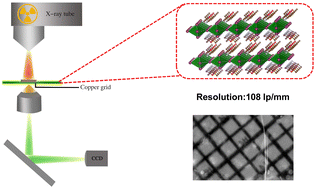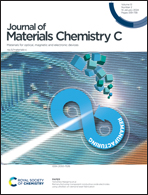High spatial resolution X-ray scintillators based on a 2D copper(i) iodide hybrid†
Abstract
Metal halides are considered as an emerging class of X-ray scintillation materials with typical advantages of high-resolution scintillating imaging, low-cost and facile preparation. Here, we report ultra-high spatial resolution X-ray imaging by using a 2D copper(I)-based cluster (CISDM)4[Cu4I8]·2H2O (CISDM = cis-2,6-dimethylmorpholine) as a scintillator material. Thin single crystals were grown by slowly evaporating a solution containing CuI and CISDMI, and determined as a 2D layered structure with the [Cu4I8]4− cluster polyhedrons connected to each other and surrounded by CISDM cations. 2D (CISDM)4[Cu4I8]·2H2O exhibits bright yellow luminescence at 588 nm and a photoluminescence quantum yield as high as 87.2%. X-ray scintillation investigation shows that this 2D hybrid displays a good linear response to X-ray dose rates and a light yield of about 41 042 photons MeV−1 as well as a low detection limit of 86.8 nGy s−1. Most encouragingly, it gives an exceptional spatial resolution of 108 lp mm−1, representing the state of the art value among those of the reported lead-free metal halide hybrids. Our work provides a design concept of copper(I)-based single crystals for the application in high spatial resolution scintillators.



 Please wait while we load your content...
Please wait while we load your content...